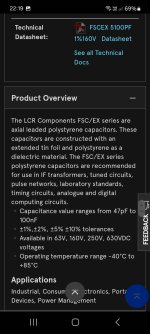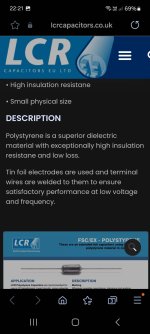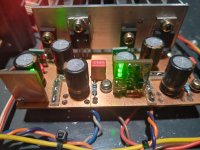The DAC's output compliance limits how big an I/V resistor can be. Some DACs have more output compliance than others - those will benefit from higher I/V resistor values and more current to get better SNR.
LCR has cool radial tin foil polystyren caps: 1%, 2%, 5% precision (Elements14, Farnell, Digikey ?) . Or just use the NOS Philips and Vishay tin foils that are excelllent.
Can you provide a link for any of those?
I do not understand what you want ? What exactly information do you looking for ? Which brand ?
Have you searched lcr at elements14?
Have you searched lcr at elements14?
https://lcrcapacitors.co.uk/capacitors/fsc-ex-polystyrene/No link then? Do you have a datasheet?
It doesn't allow me to download the datasheet in the link.
https://lcrcapacitors.co.uk/capacitors/fsc-ex-polystyrene/
It doesn't allow me to download the datasheet in the link.
Desperately trying to spot any mention of tin in the link...
Mouser has a 23P series from Xicon, it is not much worse than LCR, but I would definitely recommend a quality COG or PPS if it is a faster op amp in the I/V stage.Can you provide a link for any of those?
I have been listening this amplifier for little less than a month and I must admit that the AD811 is an ideal partner for it, without any preamplifier, the output is only connected via 10K ALPS, again without any capacitors and I must admit that the sound is better than with Le Monstre.
The surprises never end 🙂
The surprises never end 🙂
Potresti usare l'ingresso +ve ma ci sono amplificatori operazionali audio migliori.
Non sono mai stato convinto che l'811 sia una buona scelta, mentre lo è l'AD844, per i DAC con uscita in corrente
Please, I am already using an output stage for tda1541 with 3x AD844 in parallel followed by 1x AD 817 and I am very satisfied with it, but now I would like to know your opinion also on AD844 vs AD811.You could use the +ve input but there are better audio opamps.
I've never been convinced that the 811 is a good choice, whereas the AD844 is, for current output dacs.
Antonio
I would be curious to listen to an op861 as I/V buffered with an op828 or ad811( as a buffer too), something plus to make to my to do list...
I think due to the spec, op828 to be the best choice as buffer, but only for real tests should be made.
I have not used the AD811 myself. The 844's opamp can be bypassed by taking the output from the Tz pin.Please, I am already using an output stage for tda1541 with 3x AD844 in parallel followed by 1x AD 817 and I am very satisfied with it, but now I would like to know your opinion also on AD844 vs AD811.
Antonio
Last edited:
@tonimxp ,
The 817 has very good specs, before changing the I/V AD844s you could also experiment on the buffer only if your desoldering skill are ok to solder/desolder several times w/o damaging the fragile traces.
What could be diffirent is of course to try here too a CFA or a JFET (op828, op1541 if low buffer needs or opa1655 if more mA needed)
If your layout permits it (inverted input ?) and want to try the AD811 as a buffer (the end of the paper of W Jung grunf linked already several times talk also about that possibility), you will need though at the AD811 inverted pin a >=600R to <= 1K.
op828 has a crazy low noise figure and has a sorta of said analog sound to me, although I have not tried it as a buffer yet but more as I/V because of that and it is Jfet (good to figth glitches dac current ic output).
Of course if you populate brandnew board, possibilities are numerous 🙂
The 817 has very good specs, before changing the I/V AD844s you could also experiment on the buffer only if your desoldering skill are ok to solder/desolder several times w/o damaging the fragile traces.
What could be diffirent is of course to try here too a CFA or a JFET (op828, op1541 if low buffer needs or opa1655 if more mA needed)
If your layout permits it (inverted input ?) and want to try the AD811 as a buffer (the end of the paper of W Jung grunf linked already several times talk also about that possibility), you will need though at the AD811 inverted pin a >=600R to <= 1K.
op828 has a crazy low noise figure and has a sorta of said analog sound to me, although I have not tried it as a buffer yet but more as I/V because of that and it is Jfet (good to figth glitches dac current ic output).
Of course if you populate brandnew board, possibilities are numerous 🙂
A small upgrade in my DAC, the regulators for the AD811 have received improved references. These are made with tantalum resistors that I already use in the same regulator instead of RN60 (two PNM 1206 10K on an adapter).
I am slowly switching all the important resistors in my designs to tantalum versions, namely the PNM and PTN series from Vishay.
I am slowly switching all the important resistors in my designs to tantalum versions, namely the PNM and PTN series from Vishay.
Attachments
- Home
- Source & Line
- Digital Line Level
- AD811 as I/V stage for current DACs (and test some other opamps including Burson Audio opamps as I/V)


